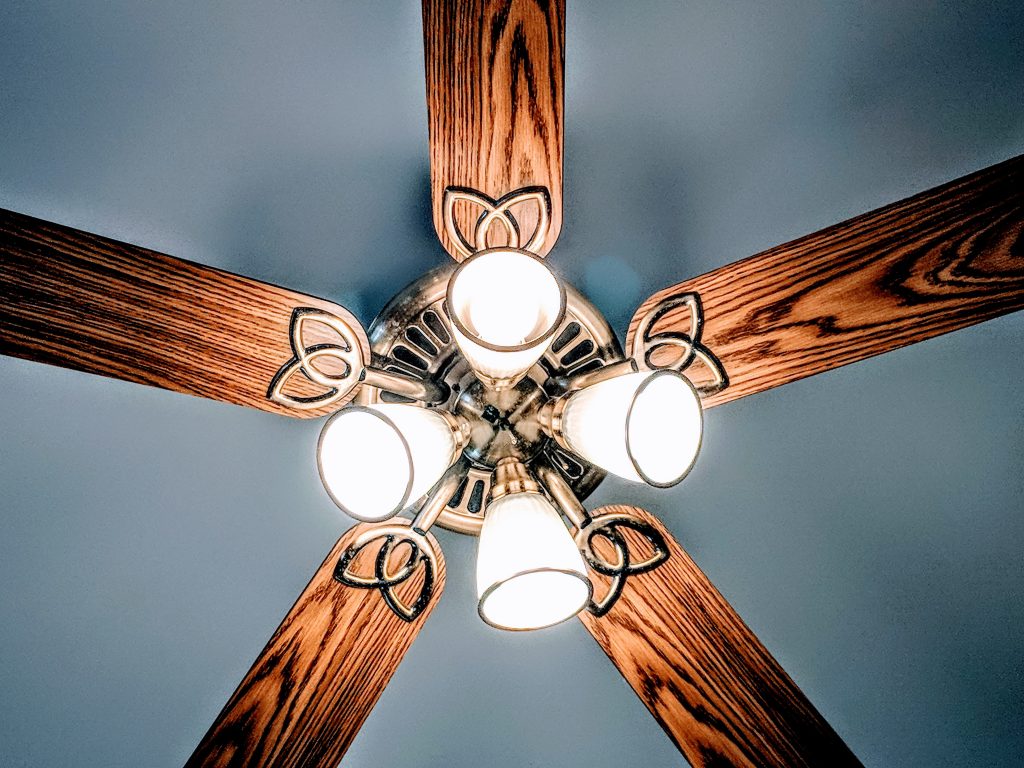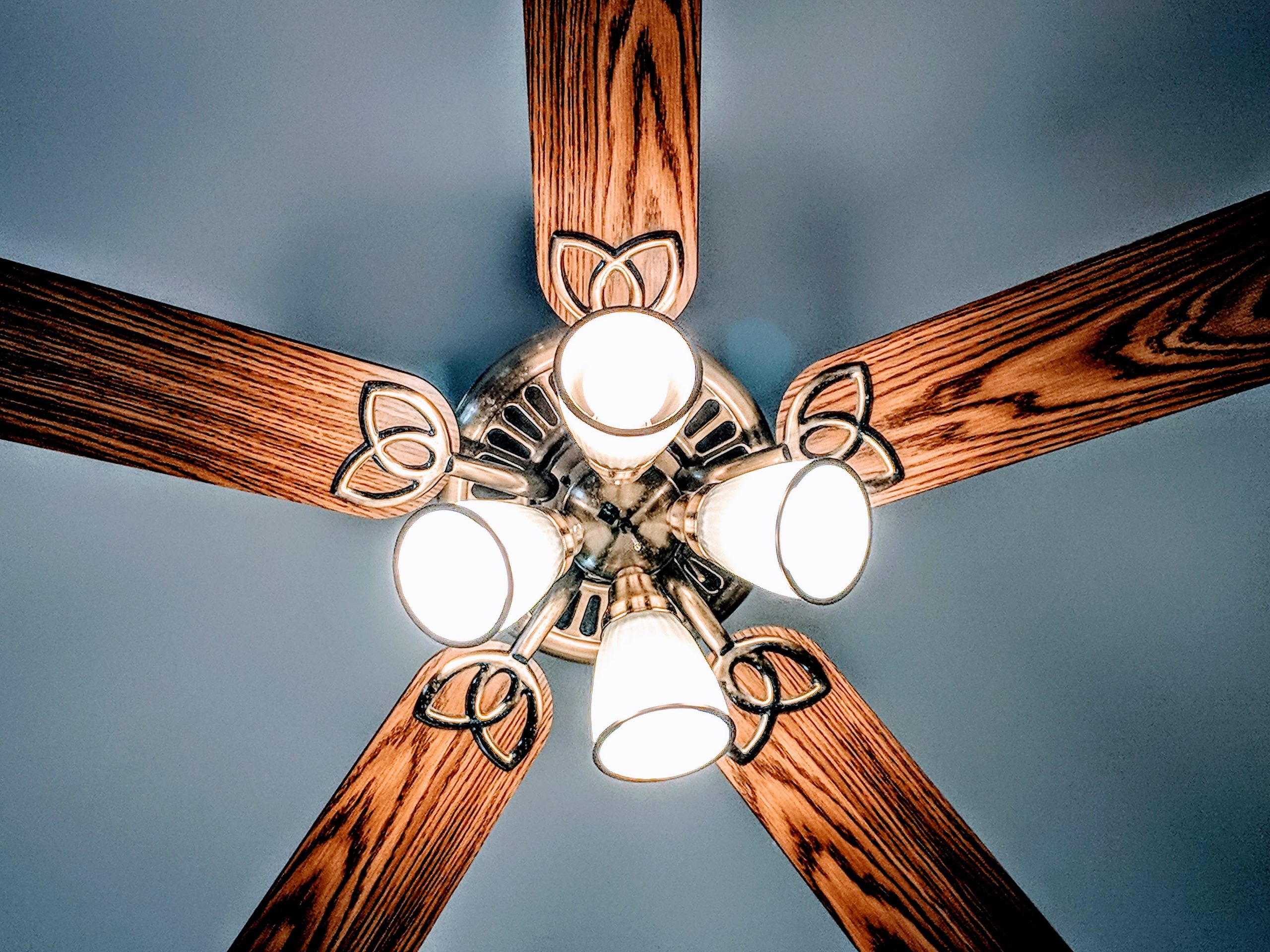What Size Of Fan For A Bedroom?
No doubt, we all know how valuable ceiling fans can be. There are various kinds of fans out there and they come in different shapes and sizes. With the multitude of ceiling fans available, it can be hard to determine just which of them to opt for. There’s no need to get overwhelmed as this guide will help you to determine what fan size is right for your bedroom.

To begin with, why do we need to make sure that we buy just the right ceiling fan size? Is there even such a thing as the right ceiling fan size? Yes, there is such a thing and it is actually very important for us to choose a fan that will satisfy all our needs. Below are some reasons why we need to talk about choosing the right fan size of the ceiling fan.
The main purpose of a ceiling fan is to make us feel more comfortable in hot or unfavorable weather. A fan that is not the right size for the room in question will not be able to achieve this purpose. If you put a small fan in a big room, it will not move air around efficiently and that won’t bring any comfort. Using a fan that is too large for a room, on the other hand, will cause too much airflow, which can result in things flying around.
Using a fan that’s larger than you need also means higher energy consumption. And not only does this lead to a higher electricity bill, but it is also harmful to the environment. A fan that is just the right size for a room will be helpful in saving energy and costs too.
Apart from the cooling function of ceiling fans, they can also be used as accessories. We can make a room look even more beautiful with a fan that has an amazing design or color. A fan that is out of place will certainly not give us of this needed effect.
Now, before we go on to see some steps to follow when you want to get a fan with the right size, let’s identify the various types of ceiling fans:
Table of Contents
Types Of Ceiling Fans
Standard Ceiling Fans: These kinds of fans are the most common ones and they will likely be seen in most homes. They are for rooms which are 8 feet high or more and they typically come with a down rod. Standard ceiling fans usually have about 4 or 5 blades.
Energy Star Fans: They are environmental-friendly and they use less energy than standard ceiling fans. They are also more efficient and all these factors help to save us some extra money on our bills. Also, due to a lot of people discovering these fans and their many benefits, they are becoming more popular.
Low Profile Ceiling Fans: They are sometimes called flush-mounts or huggers and they are very useful when our ceiling has a height less than 8 feet. Unlike the standard ceiling fans, these kinds of fans don’t come with a down rod. Instead, the fan is directly installed on the mounting bracket. Low profile ceiling fans can be very useful when your ceiling is too low for a standard ceiling fan. Since they don’t come with down rods, they are in line with the suggested floor clearance of 7 feet. Although the space between the ceiling and fan blades might cause the fan to create less airflow, the fan can still circulate the right amount of air.
Dual Motor Ceiling Fans: These fans come with 2 motors and each of them can be adjusted to produce even better airflow. This is possible because they both move air in many directions at once.
Steps To Choosing The Right Ceiling Fan Size
Measure the ceiling’s area
Measure the room’s height
Think about your fan’s usage
Measure The Ceiling’s Area
The first thing you need to do is to measure the size of the particular room you are getting a ceiling fan for. You need to do this in order to know the right ceiling fan size that will fit into that space.
To do this, simply measure the length and width of your room and multiply the measurements to get the room’s square footage.
Once you have this measurement, you would need to compare it with the sizing guide for the company you want to buy the fan from.
The use of a sizing guide can be very useful in picking the right ceiling fan size. It will help you to know the ceiling fan sweep(the diameter of the fan’s span) that will be just right for your room’s square footage. Generally, rooms that are smaller than or exactly 75 square feet should have a ceiling fan that is 36 inches or less in diameter.
On the other hand, rooms which measure between 75 – 144 square feet should have a ceiling fan with a diameter between 36 – 42 inches. If you are dealing with a larger room that has square footage around 225 feet, the right size is a fan of 50 – 54 inches blade span or larger.

Measure The Room’s Height
It is also important to know the room’s height. Why? This is because the ceiling fan might hit someone if it is too low and you definitely do not want that. If the right ceiling fan for the room in question is a large one, then it is important to note that large fans have a larger drop from the ceiling and will be lower.
Regardless of the chosen ceiling fan, it is recommended that there is a 7 feet space between the fan and the floor. This implies that installing a ceiling fan in a room with a low ceiling might not be the best choice- remember we don’t want anyone to get hurt.
It also implies that you have to carefully check the drop of ceiling fans you intend to purchase and be sure that even at its maximum, the space between the blades and the floor will be around 7 feet.
On the other hand, if you have a room with a height that’s much higher than 7 feet, then you can get something that’s called a “down rod”. It helps to lower the fan, thereby making it closer to the floor.
Someone with very tall ceilings may want to opt for this as the fan can move air around the room better. Low ceilings, on the other hand, will need the fan to be flush-mounted.
In case you are confused about what a down rod is, let’s give you a brief description of it. A down rod is a pipe made of metal that keeps the ceiling fan stable and ensures that there is no wobbling of any kind.
It also helps to make sure that a room gets proper airflow by keeping a safe distance between the ceiling and the fan blades.
Furthermore, it ensures a safe distance between the floor and the fan blades which is at least 7 feet. They can be found in various lengths and diameters too.
Most ceiling fans you would find come with a down rod which can be between 2 – 10 inches in length. These are just right for a standard-size room with a height between 8 – 9 feet. Note, that down rods can go as far as 177 inches.
Watch the video below for a proper understanding of down rods and how to install them on your ceiling fan.
Get Rid Of Any Obstacle
Now that we know about measuring a room’s height and size in order to get just the right size of the ceiling fan, the next step is to check for obstacles.
What does this imply? Well, an obstacle, in this case, would be anything that is in the way of the fan blades. This could be a light or any other fixture that will hinder the rotation of the blades. See why we say it is an obstacle?
Now, what do you do if you happen to have an obstacle on the ceiling? The obvious answer is to get rid of such an obstacle. But what if the obstacle can’t be moved from its position? We all know that breaking down the ceiling is not really an option. Well, what you can do in such a situation is to reduce the size of the ceiling fan we install. You will have to choose a downsized ceiling fan that you are sure won’t go close to the obstacle under any circumstance.
Think About Your Fan’s Usage
Most people might not realize this but a ceiling fan can be used for different purposes, depending on the person using it. While some people may need a ceiling fan just for a little movement of air, others might need a particular space to be really cool.
Factors like these can greatly determine the kind of fan that is chosen. Why is this fan being purchased? Before you select a fan, you should consider this question. For example, someone who needs a high movement of air will need to get a bigger ceiling fan while someone who needs a bit of cooling can choose a smaller one.
Also, you should also think about the features you’d love your ceiling fan to have. There are ceiling fans that come with a light in them so that they can function as a fan and as a source of light as well- cool, isn’t it? If you want a fan like this, you just have to keep in mind that fans that come with light kits will need greater depth though to accommodate the light. This simply means you need to have a higher ceiling for them to work for us.
Can Your Ceiling Handle Your Fan’s Weight?
Generally, the fan’s manual should contain some information about ceiling support. If you have lingering doubts about the right amount of ceiling support you have for the ceiling fan, the best thing to do then is to get an electrician. After a check, the necessary additional supports can then be added.
Before shrugging this part off and moving on, think about what can happen if this part is neglected. It is ideal for all ceiling fans to be equipped with additional supports along with their electrical box. However, ceiling fans with really large fan blades will have more weight and will need more support as a result of this.
Additional Factors To Be Considered
You also need to consider some other factors when choosing a ceiling fan as they can have an effect on air circulation in the room. Some of those factors are:
- The noise the ceiling fan makes. A noisy fan might not be very suitable for places like a study or a bedroom.
- The height of the ceiling itself. If a ceiling fan is too long, it can hinder its ability to create airflow.
- Budget. It goes without saying that you need to consider your budget before getting a fan. You definitely don’t want to go broke or break the bank just because you want to get a fan. There are a lot of decent fans that are still very affordable.
Check out these other articles
- How to design a bedroom
- Where to buy bedroom sets
- How to get rid of bedroom odor
- How to get rid of weevils in my room
- How to make your bedroom cozy
- What is a studio apartment vs one bedroom?
Conclusion
It is needless to say that fans can be very beneficial to us in getting our desired temperature and/or look in our bedroom. However, we need to be sure that we consider all the necessary factors before deciding on a fan for our use.
Take some time to review some ceiling fans and pick the one that satisfies all needs. If you’re just moving into a new room and are looking for the best way to design it, check out our article on How To Design A Bedroom.
What Size Of Fan For A Bedroom? – Frequently Asked Questions
Is a 3 or 4 blade fan better?
Four blade fans are quite common. They are less noisy and are useful in rooms that are fitted with air conditioning. Four-blade fans move around very effectively. They are often designed stylishly, with modern four-blade fans fitted with light bulbs. Four blade fans are however slower than three-blade fans. Three-blade fans optimize airflow and are faster than four-blade fans thanks to their aerodynamics. There is lower air friction on the blades of a 3-blade fan and this makes them move faster. They also have a more manageable load than what is obtained on 4-blade fans.
Which type of fan gives more air?
Fans do not exactly “give air”, rather, they circulate air by moving air masses around with speed. Ideally, the higher the number of blades on a fan, the higher the airflow produced by the fan. But there is also a drawback of air resistance with an increase in fan blades. For this reason, 3-blade fans produce the optimal airflow obtainable for a given fan blade length. 4-blade fans are also effective for adequate aeration but they increase the load on the motor of the fan.
Should you run ceiling fans all day?
It is possible to run your ceiling fan all day and there might be a good reason for it as it will ensure the room is well aerated even when no one is present. However, one must also consider the costs of energy consumption of the fan as it aerates the room even when no one is there. It can be argued that this is a waste of energy. In a world where energy conservation is increasingly more important, the moral thing to do is not to run your ceiling fan all day, especially when no one needs it.
What is the best ceiling fan for a bedroom?
There are lots of ceiling fans in the market today. This makes singling out one fan as the best all the more difficult. That said, the best ceiling fan for a bedroom will be one that is able to aerate the room efficiently whilst consuming low energy. It should also contribute to the aesthetics of the room. In line with these, some of the best ceiling fans to consider include the Emerson Model Ceiling fan, Westinghouse Harmony Indoor ceiling fan, Hunter 53091 builder deluxe fan, and the Westinghouse 7801665 Comet collection fan.
What should I look for when buying a fan?
The main purpose of a fan is to effectively aerate a room. Therefore one of the most important things to consider when buying a fan is the number of blades. Typically, more blades result in more expensive fans. So 4-blade fans are more expensive than 3-blade fans. However, 3-blade fans are equally as effective, if not more. You should also lookout for the style and finishing of the fan and consider how it fits with the interior decor of your space.
How do I choose a wall fan?
To get a good working fan that does its job effectively, you need to consider its size. Select a fan size that fits your living space and provides adequate airflow. Also, you should look out for a fan with adequate speed. Pick a fan that is able to provide effective airflow even at low to medium speed settings. Finally, look out for the style and finishing of the fan and consider how it matches with your interior decor. Check for the control type too – whether it uses a remote, a wall dial, or a rotary switch, depending on your preferences.

